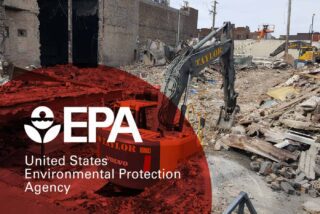
Asbestos is still not banned in the United States, despite the warnings and concerns of scientists and advisors. Asbestos is known to cause a series of diseases, including malignant mesothelioma, an aggressive cancer. The Environmental Protection Agency (EPA) has put various rules and regulations into place to help protect the public and the environment from the dangers of asbestos, however, their recent rule calls their protections into question.
The EPA’s New Rule
Last month, April 2019, a new rule was put into place by the EPA to further regulate asbestos manufacturing and use in the United States. This expands upon the 1989 Partial Ban, adding an array of products to the list of asbestos materials not allowed in the United States. As part of this new rule, products banned that won’t be able to enter without EPA approval include adhesives, sealants, roof coatings, arch chutes, certain gaskets, asbestos cement products, certain tapes, acetylene cylinder filler, certain friction materials, high-grade electrical paper, millboard, missile liner, packings, pipeline wraps, reinforced plastics, roofing felts, and much more, including many asbestos building materials.
Under the New Rule, all asbestos products must be approved and reviewed by the EPA, and the EPA must be notified 90 days before the products are manufactured, imported, or processed. After review, the EPA will be able to put restrictions or prohibitions in place where they feel necessary, determining whether or not an asbestos product can enter the American market.
Disregarding the Need for an Asbestos Ban
Responses to the New Rule have been divided with both positive and negative reactions. Those pleased with the New Rule feel that it covers products previously left out, offering more protection and addressing products that were previously allowed into the United States with complete freedom. Now, they are subject to EPA review and approval, and more products are banned.
However, with varying levels of support, there is a large amount of concern and discontent amongst those advocating for a full ban on the toxin. Those in opposition feel that the EPA is not only leaving the door open to the manufacture and use of other asbestos materials but potentially allowing for even more harmful uses. Asbestos products previously not allowed into the United States now can return. The products must get approval, but whereas they were completely banned before, there is now a possibility for them to return. This could in turn open up more ways for companies to manufacture asbestos, encouraging its use despite the numerous risks.
How Agency Experts’ Warnings Were Ignored
Two internal memos were obtained by the Asbestos Disease Awareness Organization (ADAO) and later shared with The New York Times. Within the memos, the EPA’s scientists and lawyers strongly advised that asbestos be completely banned instead of solely being restricted. The memos were issued back in August, noting that asbestos should be banned because of how the “extreme harm” outweighs any potential benefit. Experts also asserted that alternatives to asbestos are available.
EPA officials and other experts are surprised that the warnings were ignored, despite the fact that the EPA has cut back on other environmental protections. A standard proposed for cleaning up toxic chemical groundwater pollution was weakened by the EPA shortly after. A ban had been proposed on deadly chemicals found in paint strippers but was also scaled back by the EPA. Agencies proposed a ban on the use of the pesticide chlorpyrifos, linked to illnesses and children’s disabilities. The ban was later rejected by the EPA.
While all of these actions are concerning, the risks and damages of asbestos are extremely well-known, leaving little excuse to not have the material completely blocked from the United States, as it is in 66 other nations. Several advocates of a ban have spoken out since April’s rule. ADAO’s president, Linda Reinstein has vocalized her concerns that the rule is “toothless” and opens the door for some asbestos products to return to the market. The chloralkali industry also continues to import tons of raw asbestos, which is not addressed by the rule. Reinstein also notes that the EPA isn’t addressing “legacy asbestos” prevalent throughout our homes, at the workplace, and in schools.
Prompts for Further Action Against Asbestos
Mike Walls, Vice President of the American Chemistry Council’s Regulatory and Technical Affairs, stated that his organization wouldn’t support a ban until a congressionally mandated evaluation of asbestos was completed. Many feel that the results of this review will confirm whether a regulation is sufficient or if a ban is needed. Walls feels that asbestos shouldn’t be banned solely because it’s hazardous, especially if the risks of asbestos exposure can be managed.
The memos previously mentioned proof that the EPA is concerned about the review process. They are only evaluating six fibers of asbestos when there are many other fiber types proven to be harmful. Critics are also concerned that lung cancer and mesothelioma are the only risks being addressed. Furthermore, as Reinstein stated, legacy issues from previous mishandling of asbestos are being ignored.
With so many disappointed with the New Rule, more and more are speaking out about the need for a ban. Key advocates are spreading the word of the dangers of asbestos, hopefully helping push the United States closer to being asbestos-free.




